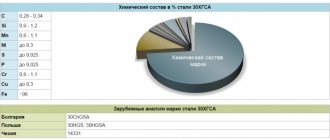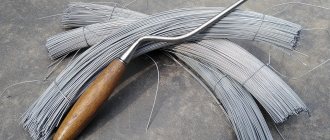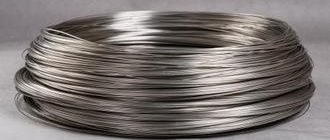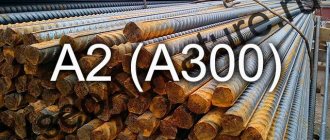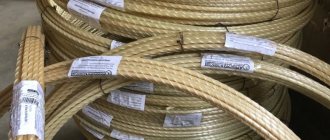Concrete is a very durable building material. Thanks to its strength, it is so widely used in construction and repair work.
But concrete also has its weaknesses:
- low tensile strength during bending;
- tendency to shrink;
- formation of cracks;
- low impact strength, due to which it splits and becomes cracked under impact load;
- porous structure that can absorb water, making concrete susceptible to mold and mildew.
There are various ways to make concrete flawless: special additives added to the solution give it density, viscosity, and water-repellent properties. Depending on what additive is used, concrete with different characteristics can be obtained.
To increase the strength of concrete structures, including bending and tensile strength, reinforcement is used using anti-shrink mesh or reinforcement cage.
But reinforcing concrete in this way is an expensive and time-consuming undertaking.
A modern alternative to reinforcement is the use of special fiber for concrete, which is added to the concrete solution. Due to its properties, fiber is called micro-reinforcement and is considered as an alternative to traditional reinforcement.
What is fiber fiber
Concrete has specific characteristics that define it as a brittle substance with a heterogeneous structure. Its ultimate deformation value is much lower than, for example, glass, steel or polymer composites.
To increase elasticity, it became necessary to use fibrous additives (fiber) as micro-reinforcement for concrete structures. This feature has found wide application in the technology of construction processes, such as the preparation of cement mixtures, the production of high-strength materials, etc.
Fiber is a material in the form of lengths of threads or narrow strips of organic or inorganic origin. The mechanical characteristics of fiber-reinforced concrete depend on the number and arrangement of fibers in the solution.
The method of dispersed reinforcement of concrete provides for arbitrary and directional orientation of the fibers.
Directional involves the use of thin continuous threads, woven and non-woven meshes, strands and other similar materials. Free (free) occurs when using rolled materials in the form of mats, canvases, veils.
Flaws
There are downsides to this popular metal filler. And above all:
- its presence increases the weight of concrete products;
- there is not always good adhesion strength to cement (more often when using smooth workpieces or using lean concrete mixtures with a large amount of sand);
- it is possible for material to escape from the concrete body under conditions of long-term operation (especially noticeable in road construction during repair work of the road surface);
- applying an additional corrosion or other protective coating leads to additional costs and an increase in the final cost of the product.
These properties, however, do not affect the popularity of such a building material and it is widely used by modern consumers.
Main components of the supplement
The technology for manufacturing additives depends on the type of reinforcing components used. Not all fibers meet the requirements for reinforcement cages.
Metallic and non-metallic threads of different lengths and cross-sections are used as fibers:
- In terms of construction, the greatest effect is obtained from the use of steel fibers, the deformability modulus of which is 6 times higher than that of concrete.
- The use of polypropylene can reduce the risk of cracking during plastic shrinkage of mixtures by 60-90%.
- Glass fiber has low alkali resistance and is used only for preliminary reinforcement in the manufacture of gypsum products or wall blocks made of cellular concrete.
- Basalt fiber is resistant to alkaline processes. The elastic modulus is 15-20% higher than that of glass fibers.
- Asbestos fibers are neutral to the aggressive effects of cements and are characterized by high strength and fire resistance.
A rational choice of additives for concrete reinforcement makes it possible to obtain products that are resistant to mechanical loads.
Fiberglass has low alkali resistance.
Is fiber needed for screeding, and which one should I use?
When making screeds, it is important to maintain a balance between two mutually exclusive tasks:
- ensuring high strength (which is directly proportional to the thickness of the screed);
- minimum thickness of the screed (to save materials and maintain the ceiling height as much as possible).
The addition of polypropylene fiber helps to solve this contradiction. It is recommended to add it both to the solution for wet screed and to the mixture for semi-dry screed, regardless of whether mesh reinforcement is used.
Fiber fiber not only increases the strength of the screed and reduces its abrasion, but also prevents shrinkage and cracking, increases the impact strength of the surface, preventing cracking and chipping during operation. The screed with the addition of fiber fiber is strong and durable.
Video: Screed with fiber is stronger than with reinforcement!
Advantages
The widespread use of fiber-reinforced concrete is due to the fact that its physical and mechanical properties are several times better than those of traditional materials. At the same time, the performance characteristics of the products comply with the standards.
Strengthening the screed
To strengthen coatings, it is recommended to use steel fibers with a length of 35-75 mm and a diameter of 0.3-1.0 mm. Heavy concrete of class B25-B35 with a coarse aggregate size of no more than 20 mm is chosen as a cement matrix.
The use of dispersed reinforcement with steel fibers will enhance the performance properties, strengthen the top layer of the base, increase wear resistance, bending strength, crack resistance and durability of the structure.
Prevention of defects
The occurrence of defects in concrete pavements is associated with a violation of the technological process. This is explained by thoughtless savings, non-compliance with the norms and rules provided for this type of structure. Such negligence leads to the appearance of cracks, chips, and potholes on the surface.
As practice has shown, the most effective means for preventing and eliminating defects that have arisen are repair solutions reinforced with various types of fibers. The use of steel or polypropylene fiber makes it possible to avoid the delamination of mixtures during the laying period, and subsequently premature wear and destruction of coatings.
Improved adhesion and water resistance
The water resistance of concrete can be improved using dispersed reinforcement. Since the properties of fiber-reinforced concrete depend on the characteristics of the fibers used, by choosing a material with the necessary characteristics, you can successfully solve the problem.
For example, the use of steel and basalt fibers will increase the water resistance of products several times. To obtain better adhesion of fibers to the cement matrix and uniform distribution of fibers, it is necessary to correctly select the optimal length and diameter of the segments used.
Cost-effective and anti-corrosion properties
The use of fiber for reinforced concrete structures, when part of the frame is replaced with dispersed fibers, allows one to obtain tangible benefits, since the price of modifiers is much lower than the cost of rod reinforcement.
Another big advantage of using steel fiber is that it is protected from corrosion by a dense cement coating.
With proper use of additives, you can obtain an economically useful product with improved performance properties.
Types of fiber fiber for concrete and its properties
The introduction of modifiers in the form of fibers into concrete helps to improve operational and performance characteristics. The mechanical properties of fiber reinforced composite materials depend on the type of additive, volume and size of the elements.
Steel fiber
Metal fibers used as reinforcement cages are produced by various methods:
- electromechanical;
- mechanical;
- from molten metal by molding.
The most widespread are mechanical methods, using which the following types of materials are obtained:
- Wire fibers, which are pieces of thin wire 10-50 mm long.
- Sheet fibers are produced by milling a thin sheet of metal.
- Ultra-thin ones are made by melt extrusion and subsequent drawing through diamond filters.
Steel fiber.
Advantages of dispersed reinforcement with metal fibers:
- resistance to dynamic and static loads increases;
- crack resistance;
- wear resistance;
- seismic resistance;
- frost resistance.
With a fiber content of 0.5% or more, the workability of the mixtures increases. With an increase in the volume of the additive in the range of 02-0.8%, an improvement in tensile-compressive strength is observed.
Glass fiber
This group of additives is produced from silicate materials and molten volcanic rocks. Glass fiber has a length of 20-40 mm and a diameter of 10 microns. Its main feature is its high tensile-compressive strength (1500-3000 MPa). The elastic modulus of such modifiers is several times higher than that of concrete.
For cement matrices, glass threads woven into bundles are used. The harness is divided into segments of equal length, the exact dimensions of which are specified by the technological map.
Asbestos fiber
To reinforce concrete, sections of fibers, veils, canvases and materials in the form of non-woven meshes are used.
Asbestos fibers have the following qualities:
- high strength (300 kgf/mm²);
- fire resistance (up to 1500 °C);
- resistance to alkaline environments (9.0-10.1 pH);
- low electrical and thermal conductivity (0.045-0.065 W/m∙K);
- durability.
When reinforcing concrete, sections of fibers and materials in the form of non-woven meshes are used.
The tensile strength of asbestos fiber exceeds the similar properties of steel.
Basalt fiber
Basalt fiber is equal length pieces obtained from molten natural stone of volcanic origin.
The introduction of additives improves the following indicators:
- crack resistance - 2 times;
- frost resistance - up to 500 cycles;
- impact resistance - 5 times;
- elastic modulus - by 30-40%;
- by 20-50% - compressive strength;
- waterproof - 50%.
Basalt fibers provide high adhesion to the cement matrix, do not corrode and do not ignite under the influence of open fire.
Polypropylene fiber
Polypropylene fiber is an alkali-resistant material, compatible with cement and gypsum binders.
It is a synthetic fiber with a diameter of 0.02-0.038 mm. Fiber is made from polypropylene film by cutting and twisting into bundles. The tourniquet is divided into segments 0.3-0.5 mm long. In the concrete solution, the weave opens up and creates a network structure.
The use of polypropylene fiber allows you to:
- increase water resistance;
- frost resistance;
- tensile bending strength;
- increase fatigue and impact strength;
- heat resistance;
- wear resistance;
- improve the quality of the base of concrete products;
- strengthen the ability to withstand alternating loads;
- prevent mixtures from separating.
Polypropylene fiber reduces the risk of cracking by 60-90% and reduces shrinkage of concrete.
Scope of application
The choice of technical solutions for dispersed reinforcement depends on the type of fibrous materials used.
For example,
basalt fiber
wear-resistant, therefore suitable for strengthening structures used in places with increased requirements for mechanical stress:
- production sites;
- industrial floors;
- pedestrian paths with heavy traffic, etc.
The resistance of basalt fiber to chemical factors and seismic resistance allows its use in the following areas of residential and industrial construction:
- during the construction of hydraulic structures;
- in bank protection works;
- when constructing earthquake-resistant structures;
- explosive objects;
- in the production of chemically resistant reinforced concrete pipes for transporting aggressive liquids.
Basalt fiber is widely used in various areas of residential and industrial construction.
Basalt fiber is an indispensable component in the production of aerated concrete, foam concrete and other products made from cellular concrete, and also serves as a structure-forming material in the manufacture of shaped products for small architectural forms.
Steel fiber reinforced concrete is used
in the construction of structures requiring increased strength:
- Monolithic structures: highways, industrial floors, screeds, etc.
- Dams, breakwaters, irrigation canals, tanks for liquids, tunnels.
- Defensive structures.
- Reinforced concrete structures: production of prefabricated foundations, piles, wall panels, beams, columns, pipelines.
- Construction of road, airfield and sidewalk coverings.
Using polypropylene fiber
recommended when performing the following types of work:
- installation of industrial floors and screeds;
- construction of external walls, insulation based on cellular concrete blocks;
- production of piece decorative products (paving slabs, borders);
- preparation of mortars, shotcrete mixtures, plasters.
Asbestos fibers
used for reinforcing materials with low elasticity:
- roofing wavy and flat coverings;
- free-flow and pressure pipes;
- strengthening modifying additives for the top layer of concrete;
- decorative facade slabs;
- repair compounds, asphalt mixtures.
glass fiber
used for the construction of houses, sewer wells, etc. However, the insufficient resistance of the fibers to the effects of the hydrating cement environment limits its use.
Material consumption
In each specific case, the fiber consumption is different. This is explained by different areas of operation of the finished structure and different levels of force and mechanical impact. Fiber consumption for building mixtures is presented in the table:
| Product type | Consumption per cubic meter of cement-concrete composition in kg |
| Concrete with a porous structure | 0,6—0,9 |
| Concrete screed | 1,8—2,7 |
| Small architectural form | |
| Concrete for road surfaces | 1—1,5 |
| Gypsum objects produced by casting method | 0,4—0,8 |
| Dry composition | 0,6—0,9 |
| Artificial stones | 0,4—0,8 |
| Facade cladding |
Mixing Methods
Do-it-yourself production of concrete structures using the dispersed reinforcement method involves 3 main stages:
- Preparation of fiber reinforcement.
- Preparation of the composite.
- Molding of products.
When using modifiers, the hardness of mixtures increases. As a result, concrete loses its mobility and becomes difficult to place.
Adding polypropylene
An indispensable condition for obtaining compositions with high strength and stability is a uniform supply of fiber fiber into the concrete mixer.
Work order:
- First, filler, crushed stone or gravel is added.
- Then sand is poured in and mixed dry.
- Without turning off the concrete mixer, the required volume of polypropylene fibers is introduced.
- Cement and water with plasticizers dissolved in it are added.
- Continue stirring until a homogeneous mixture is obtained.
Introduction of basalt
To achieve good adhesion and the required reinforcement effect, the optimal diameter and length of the fibers are selected.
Instructions for making basalt fiber reinforced concrete:
- Sand and crushed stone are poured into a concrete mixer.
- Add the required amount of additive and mix.
- When the unit is turned on, pour water into the mixer.
- Cement is added.
- Continue kneading until the desired consistency is obtained.
If products are prepared on the basis of gypsum or cement-sand mortar, then reinforcement is performed last.
